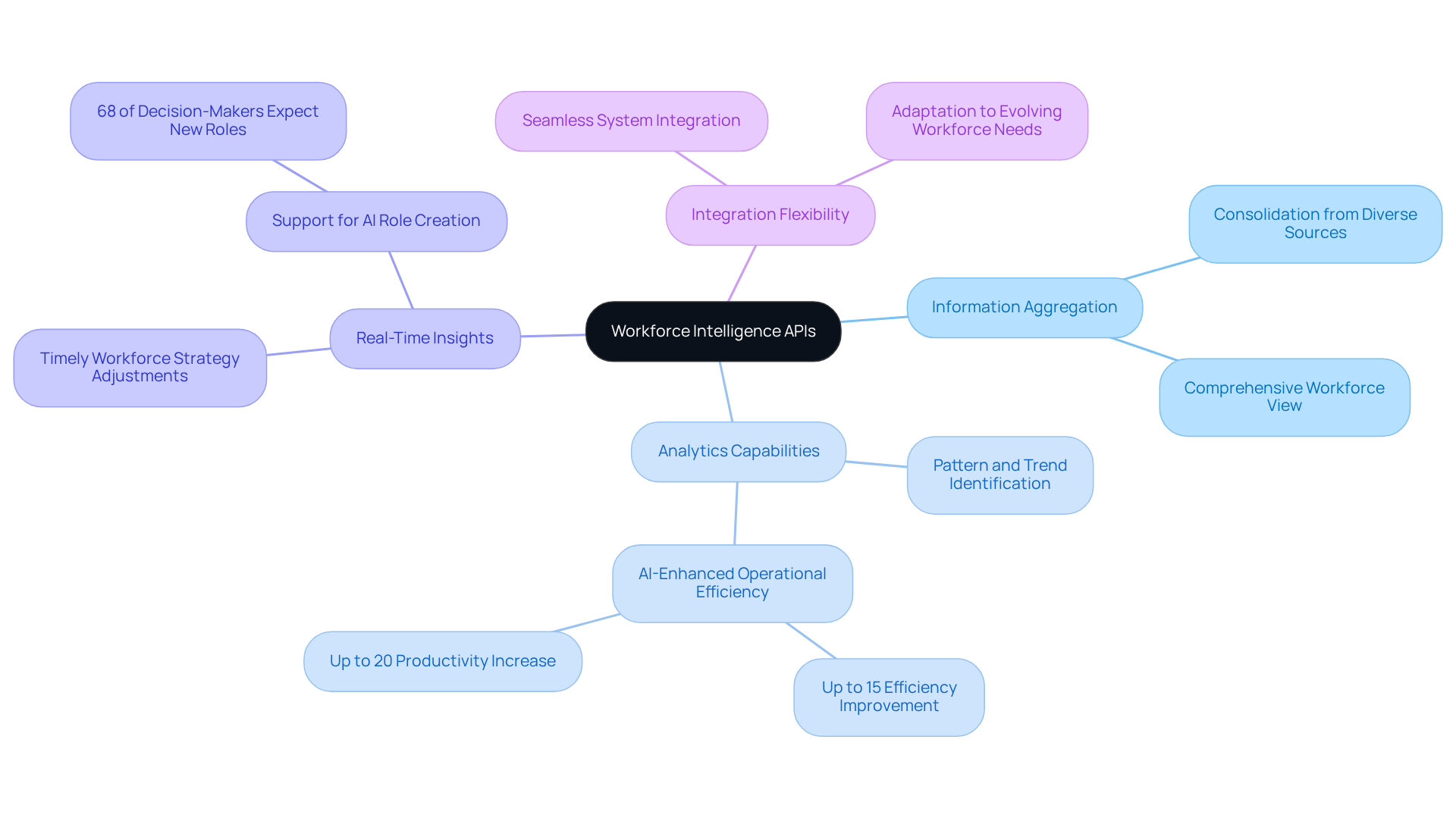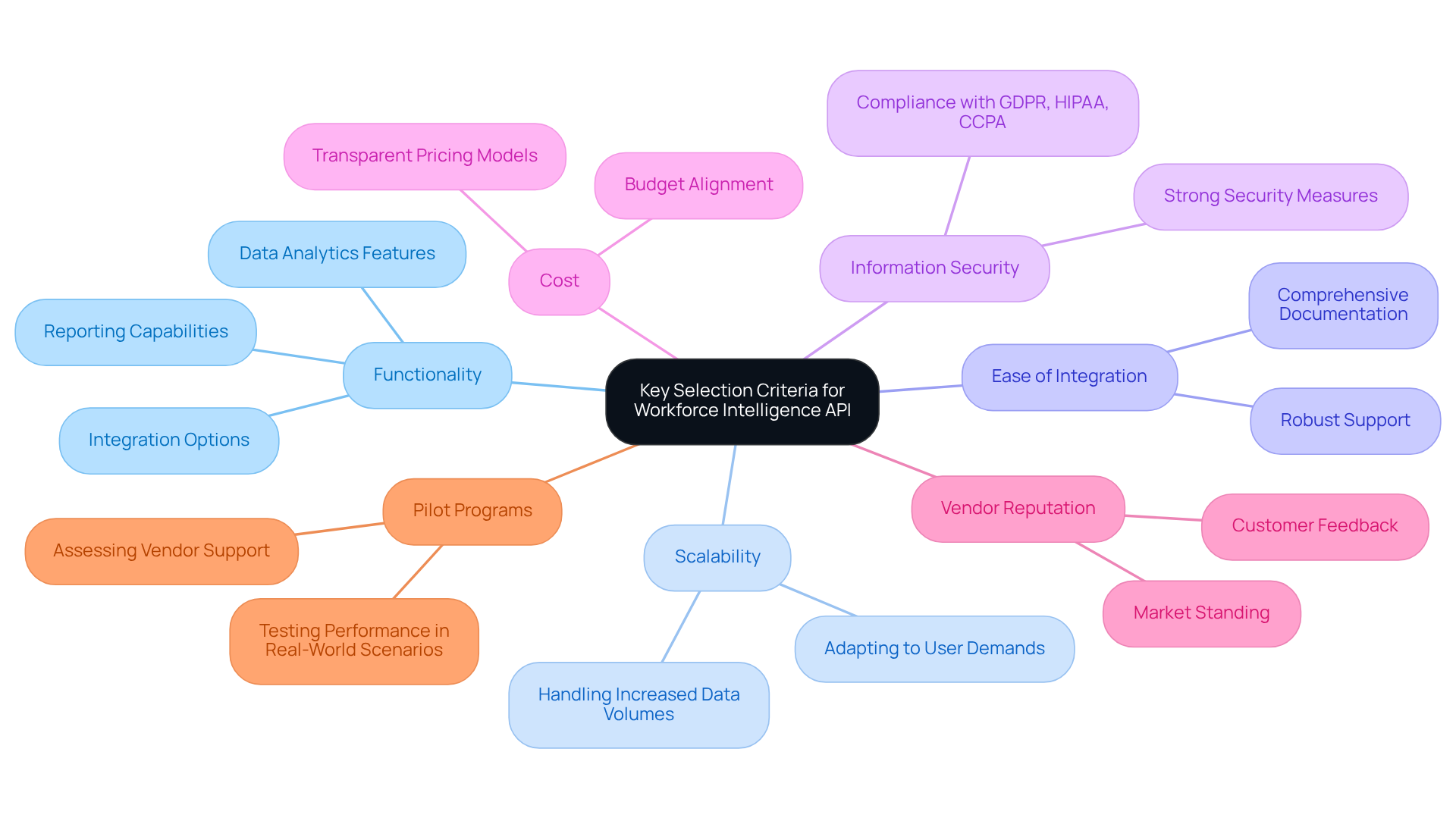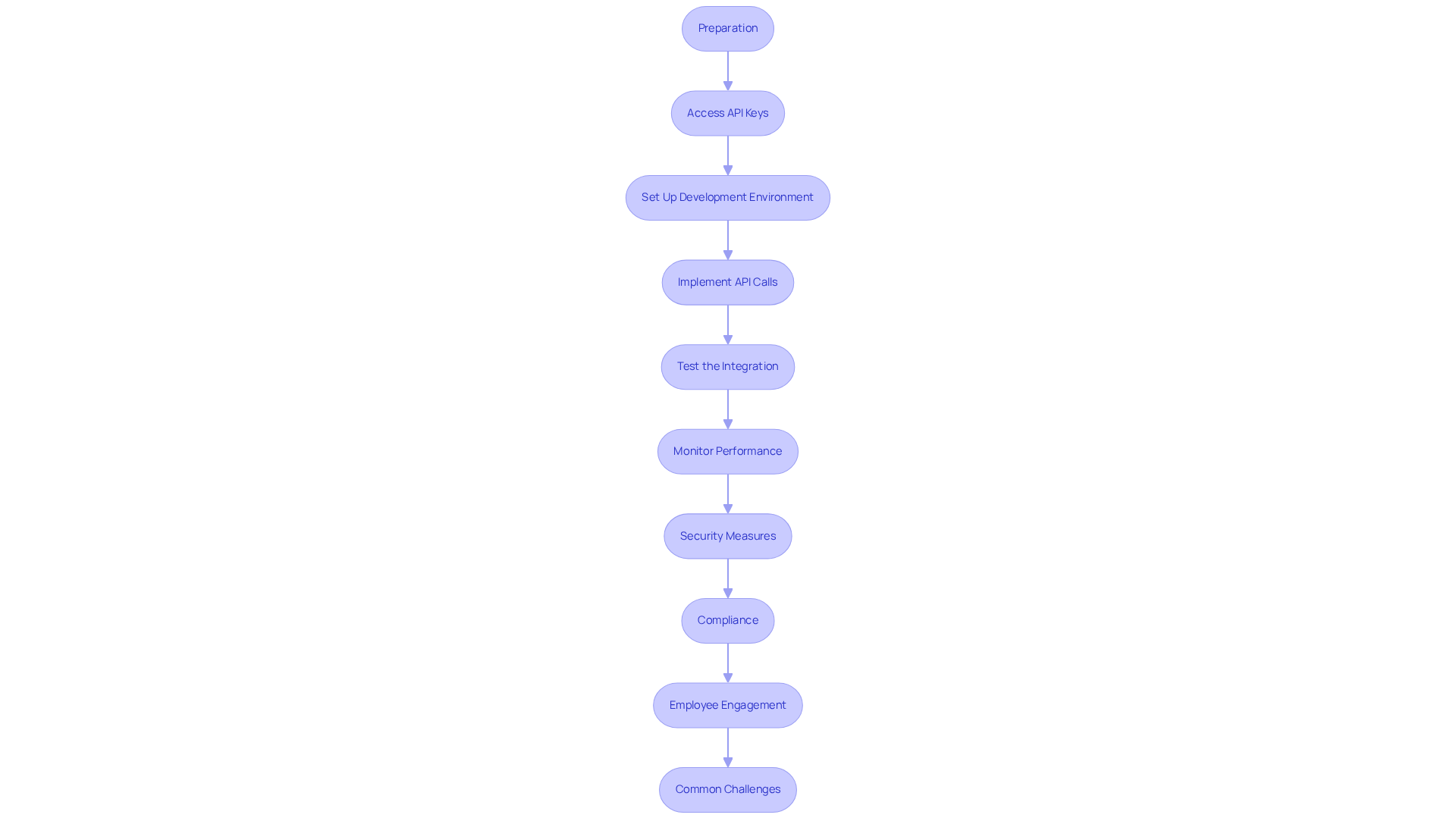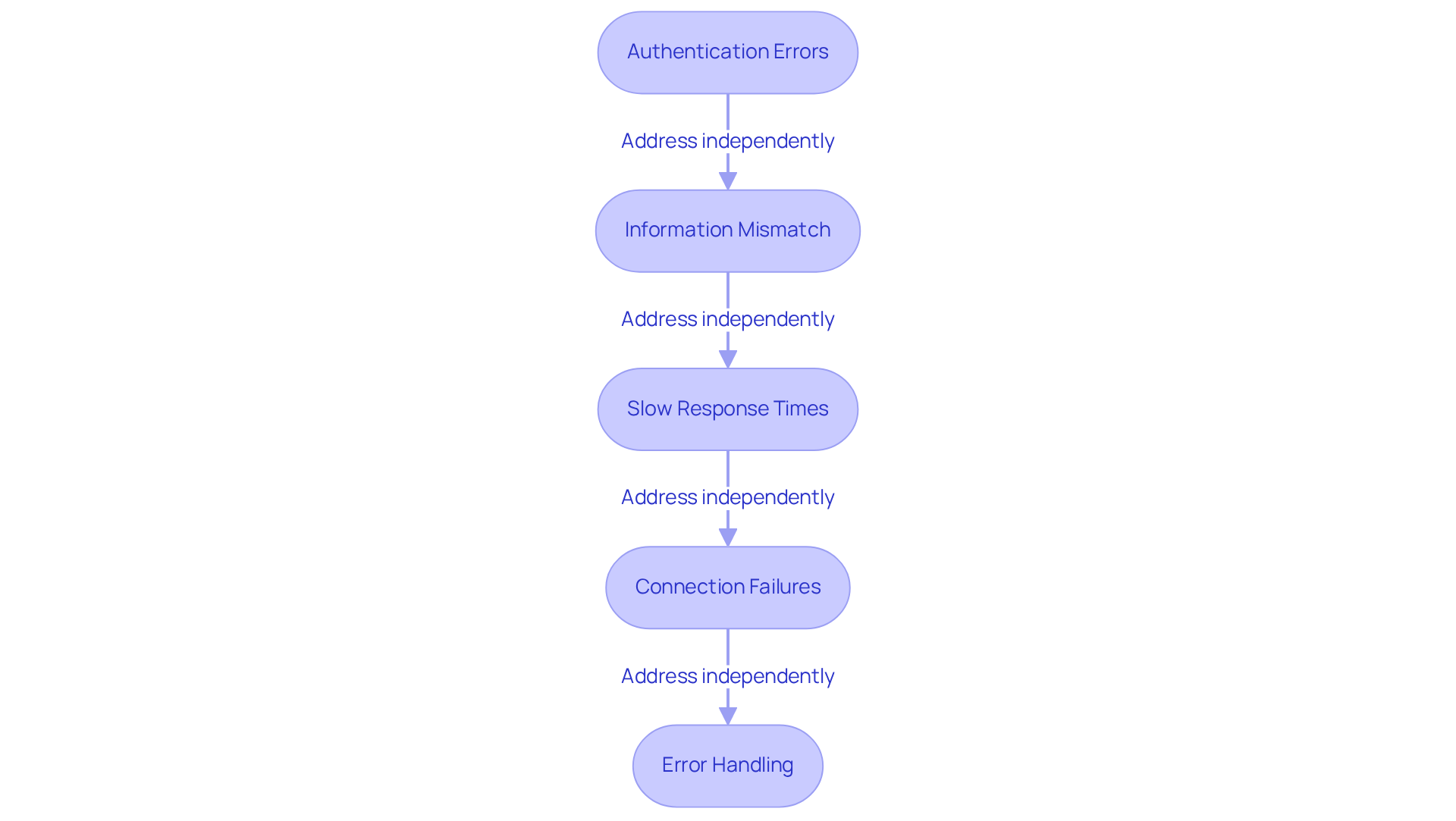Overview
To effectively choose a Workforce Intelligence API, organizations must critically evaluate essential criteria:
- Functionality
- Scalability
- Ease of integration
- Information security
- Cost
- Vendor reputation
- Opportunity for pilot programs
Each of these factors plays a pivotal role in ensuring successful API implementation and enhancing operational efficiency. Aligning the API's capabilities with organizational needs is crucial for improved workforce management. This strategic approach not only fosters informed decision-making but also positions organizations to leverage technology for optimal results.
Introduction
In a data-driven world, navigating the complexities of workforce management demands that organizations leverage advanced tools capable of providing critical insights into employee performance and workplace dynamics. Workforce Intelligence APIs stand out as powerful solutions, enabling the aggregation of data, analysis of trends, and delivery of real-time insights that can revolutionize decision-making processes. Yet, with a plethora of options available, how can companies effectively identify the right API that aligns with their specific needs and goals?
This guide explores the essential criteria for selecting a Workforce Intelligence API, addressing the challenges organizations encounter in integration and implementation while unlocking the potential for enhanced operational efficiency and employee engagement.
Understand Workforce Intelligence APIs
Workforce Intelligence APIs serve as essential resources for organizations seeking to access and analyze critical information regarding their workforce. By integrating various information sources, these APIs yield valuable insights into employee performance, skills, and workplace trends. Understanding their key components is crucial for effective utilization:
- Information Aggregation: These APIs consolidate information from diverse sources, including HR systems, performance management tools, and employee feedback platforms. This aggregation is vital, providing a comprehensive view of workforce dynamics, which is increasingly important in today's data-driven environment.
- Analytics Capabilities: Armed with robust analytical tools, Workforce Intelligence APIs enable organizations to interpret aggregated information, uncovering patterns and trends that inform strategic decision-making. For example, companies leveraging AI-enhanced analytics can enhance operational efficiency by up to 15% and increase productivity by as much as 20%. This capability is particularly pertinent as 85% of learning and development leaders anticipate a significant rise in skills development needs over the next three years due to AI and digital trends.
- Real-Time Insights: Numerous Workforce Intelligence APIs provide real-time data access, empowering businesses to make timely adjustments to their workforce strategies. This immediacy is crucial, especially as 68% of business decision-makers foresee the to support AI adoption, underscoring the necessity for agile workforce management.
- Integration Flexibility: These APIs can seamlessly integrate with existing systems, enhancing functionality without requiring a complete overhaul of current processes. This flexibility is essential for organizations aiming to adapt to evolving workforce needs while ensuring operational continuity.
By grasping these components, companies can learn how to choose a workforce intelligence API to effectively optimize their workforce management strategies, ultimately driving enhanced employee performance and engagement. As Nathan Shapiro articulates, "AI isn't about replacing people but empowering them to do more valuable work," emphasizing the positive impact of these technologies on workforce dynamics.

Evaluate Key Selection Criteria
When selecting a Workforce Intelligence API, it is essential to consider several key criteria that can significantly impact your organization’s success:
- Functionality: Evaluate the features provided by the API, including data analytics, reporting capabilities, and integration options. Ensure these align with your entity's specific requirements to maximize effectiveness.
- Scalability: Opt for an API that can adapt to your organization's growth. It should effectively handle increasing information volumes and user demands without compromising performance, which is crucial for long-term success.
- Ease of Integration: Assess how seamlessly the API can be incorporated into your existing systems. Look for those that provide comprehensive documentation and robust support to facilitate a smooth integration process.
- Information Security: Confirm that the API complies with protection regulations such as GDPR, HIPAA, or CCPA, and implements strong security measures to safeguard sensitive employee information. Clarity in information protection practices is essential for reducing compliance risks.
- Cost: Analyze the pricing structure of the API. Seek transparent pricing models that fit within your budget while still offering the necessary features to support your workforce management needs.
- Vendor Reputation: Investigate the vendor's standing in the market. Review case studies, testimonials, and customer feedback to assess their reliability and the quality of their customer support. This evaluation should include insights into their transparency regarding data practices and their ability to provide customizable solutions.
- Pilot Programs: Consider conducting pilot programs to test the API's performance in real-world scenarios before full deployment. This step is crucial for assessing the vendor's support and the API's effectiveness in fulfilling your company's needs.
By meticulously evaluating these criteria, organizations can make informed decisions on how to choose a workforce intelligence API, significantly enhancing their workforce management capabilities.

Integrate the Selected API into Your Systems
When considering how to choose a , integrating it into your systems requires meticulous planning and execution. Here are the essential steps to ensure a successful integration:
- Preparation: Begin by assessing your existing systems for compatibility with the API. A thorough review of the API documentation is crucial to understand specific requirements and limitations.
- Access API Keys: Secure the necessary API keys from your vendor. These keys are vital for authenticating your requests and ensuring secure communication with the API.
- Set Up Development Environment: Establish a dedicated development environment to test the API integration. This allows for experimentation without impacting your live systems.
- Implement API Calls: Utilize the API documentation to implement the required API calls in your application. This step may involve coding to send requests and manage responses effectively.
- Test the Integration: Conduct comprehensive testing to verify that the API operates as intended within your systems. Focus on information accuracy, response times, and error management to ensure reliability.
- Monitor Performance: After integration, continuously monitor the API's performance. Employ analytics tools to evaluate its impact on your workforce management processes and make adjustments as necessary.
- Security Measures: Implement advanced security protocols such as encryption and multi-factor authentication to protect sensitive information and ensure secure communication with the API.
- Compliance: Ensure that your system adheres to data protection laws like GDPR or HIPAA, which is essential for safeguarding user information and maintaining trust.
- Employee Engagement: Involve employees in the unification process to foster acceptance and trust. Their input can help recognize potential challenges and improve the overall efficiency of the incorporation.
- Common Challenges: Be aware of common difficulties encountered during API implementation, such as data inconsistencies and system compatibility issues. Preparing for these obstacles can streamline the integration process.
By following these steps, organizations can effectively learn how to choose a workforce intelligence API, unlocking its full potential to enhance talent management and operational efficiency.

Troubleshoot Common Implementation Issues
Organizations must navigate effectively the various challenges that arise when considering how to choose a workforce intelligence API. To address common issues, consider the following troubleshooting strategies:
- Authentication Errors: Ensure your API keys are correctly implemented within your code. Expired tokens frequently lead to authentication failures; maintaining their currency and securely rotating them can prevent access interruptions, particularly during peak usage. As one developer aptly noted, "Keeping tokens current and rotating them securely helps prevent access interruptions, especially during peak traffic."
- Information Mismatch: When the API returns unexpected information, verify the formatting of your API calls and ensure you are querying the appropriate endpoints. For instance, a grocery firm enhanced order processing by ensuring all necessary customer information was included in the payload. Similarly, a pharmacy mitigated unsuccessful requests by implementing a before transmitting data, underscoring the importance of complete information for effective API communication.
- Slow Response Times: Slow API responses can impede operations. Assess your network connection and consider optimizing API calls to minimize the data requested at once. Regularly monitoring response times, including key metrics like latency and error rates, can help identify bottlenecks early. Data shows that organizations that efficiently track their APIs can resolve connectivity issues 30% faster than those that do not.
- Connection Failures: In the event of connection problems, scrutinize the connection steps to ensure all prerequisites are met. Consulting the API documentation can clarify necessary configurations and common pitfalls. Regular monitoring of API activity is essential to prevent recurring issues and maintain smooth operations.
- Error Handling: Implementing robust error handling in your code is crucial for managing unexpected API responses. This proactive approach enables quicker identification of issues and facilitates timely corrective actions.
By effectively addressing these common implementation challenges, organizations can streamline their integration processes and learn how to choose a workforce intelligence API to fully leverage its capabilities.

Conclusion
Selecting the appropriate Workforce Intelligence API is a crucial decision for organizations striving to optimize their workforce management strategies. Understanding the core functionalities of these APIs—such as information aggregation, analytics capabilities, real-time insights, and integration flexibility—enables businesses to make informed choices that enhance employee performance and engagement. In today's rapidly evolving work environment, the focus on utilizing technology to empower employees rather than replace them is more relevant than ever.
This article delineates critical criteria for choosing a Workforce Intelligence API, including:
- Functionality
- Scalability
- Ease of integration
- Information security
- Cost
- Vendor reputation
- Benefits of pilot programs
Each of these elements is vital in ensuring that the selected API aligns with the organization's specific needs and long-term goals. Furthermore, guidance on integrating the API into existing systems and addressing common implementation challenges offers a comprehensive roadmap for successful deployment.
Ultimately, organizations must recognize that the selection and integration of a Workforce Intelligence API transcend mere technical tasks; they represent strategic initiatives with the potential to significantly enhance operational efficiency and employee satisfaction. Embracing these technologies paves the way for a future-ready workforce adept at navigating the complexities of modern business landscapes. As organizations adapt to swift changes, investing in the right Workforce Intelligence API will be essential for cultivating a dynamic, engaged, and high-performing workforce.
Frequently Asked Questions
What are Workforce Intelligence APIs?
Workforce Intelligence APIs are resources that organizations use to access and analyze critical information about their workforce, integrating various information sources to provide insights into employee performance, skills, and workplace trends.
How do Workforce Intelligence APIs aggregate information?
These APIs consolidate information from diverse sources such as HR systems, performance management tools, and employee feedback platforms, offering a comprehensive view of workforce dynamics.
What analytics capabilities do Workforce Intelligence APIs offer?
Workforce Intelligence APIs come equipped with robust analytical tools that allow organizations to interpret aggregated data, uncover patterns and trends, and inform strategic decision-making. For instance, AI-enhanced analytics can improve operational efficiency by up to 15% and increase productivity by as much as 20%.
Why are real-time insights important in Workforce Intelligence APIs?
Real-time data access provided by many Workforce Intelligence APIs enables businesses to make timely adjustments to their workforce strategies, which is crucial as many decision-makers anticipate the creation of new roles to support AI adoption.
How do Workforce Intelligence APIs integrate with existing systems?
These APIs can seamlessly integrate with current systems, enhancing functionality without necessitating a complete overhaul of existing processes, which is vital for organizations adapting to changing workforce needs.
What is the overall benefit of understanding Workforce Intelligence APIs?
By understanding the key components of Workforce Intelligence APIs, companies can choose the right API to optimize their workforce management strategies, ultimately driving improved employee performance and engagement.




